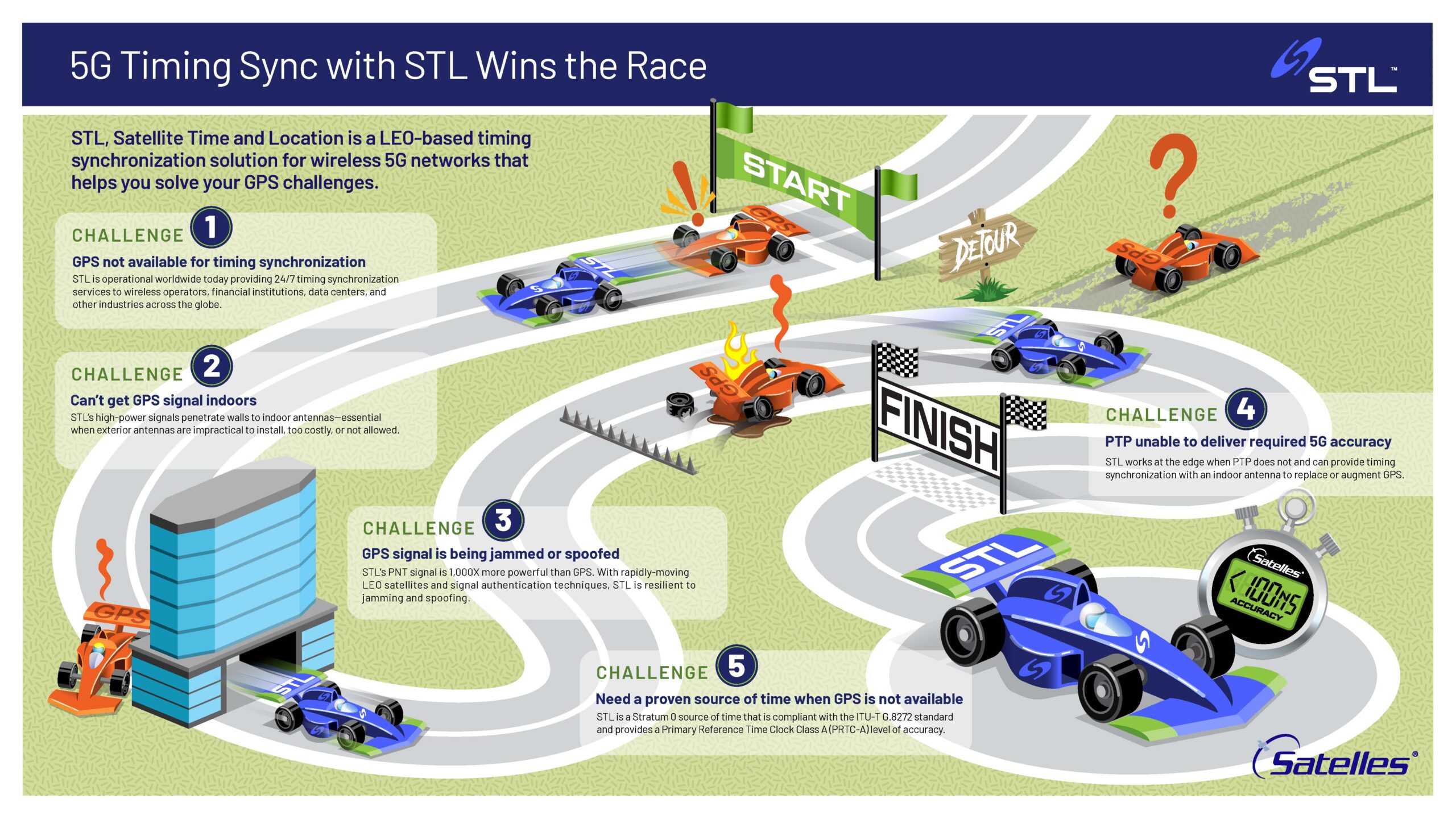Download the infographic as a PDF
5 Ways STL Solves 5G Timing Synchronization Issues
The timing requirements of 5G are more stringent than 4G/LTE and are challenged by a significant increase of the densification of nodes.
The majority of 5G sites are indoors where the Global Positioning System (GPS) and other Global Navigation Satellite Systems (GNSS) commonly fail to provide timing synchronization:
- Small cells, microcells, distributed antenna systems (DAS), enterprise systems, and picocells serving malls, hospitals, hotels, large venues, and high-rise office buildings
- Femtocells (residential 5G and broadband)
Smart telecommunications leaders are actively seeking and adopting alternatives to GPS/GNSS timing synchronization for 5G sites.
One solution is STL (Satellite Time and Location), a low Earth orbit PNT signal. STL solves common 5G timing synchronization challenges like these:
1. The STL signal penetrates indoors and occluded environments
STL’s high-power signals are 1,000 times stronger than GPS/GNSS, allowing them to penetrate walls and windows to indoor antennas.
The superior strength of STL signals is important because GPS signals originate from satellites located 12,550 miles away in space, making them too weak to penetrate indoors. Outdoor antennas are expensive, challenging to install, and vulnerable to nature:
- Elevated structures such as macro towers are susceptible to lighting strikes, which can disable receivers.
- Birds nesting on cellular towers can wreak havoc, causing lost revenue and impacting customer service.
STL antennas are significantly smaller than GPS/GNSS antennas and install indoors. This eliminates a host of outdoor antenna issues, such as government restrictions, roof rights permissions and expenses, or vandalism.
2. STL works at the edge when PTP does not
PTP is often used when outdoor GPS/GNSS antennas are not feasible. However, distributed timing using partial timing support (ITU G.8275.2) often cannot meet critical infrastructure timing requirements when there are too many network hops. Full timing support (G.8275.1) is very expensive and not always feasible or possible to implement. The number of nodes located indoors where GPS/GNSS doesn’t reach has exploded with 5G networks compared to 4G/LTE.
Customers using PTP over leased fiber typically have no idea how many hops their fiber goes through and when measured often find errors exceeding 3 microseconds!
In environments where distributed PTP is unable to deliver the accuracy that 5G requires and GPS/GNSS is not available, STL provides timing synchronization with an indoor antenna—essential when exterior antennas are impractical to install, too costly, or not allowed.
Using STL, a PTP Grand/EdgeMaster can be used to enable 5G to work with an indoor antenna. Standalone receivers connect to a wireless operator’s RAN gear or router to replace or augment GPS/GNSS so that STL provides timing sync whenever and wherever needed.
3. STL is operational worldwide today.
An innovative mesh architecture of low Earth orbit (LEO) satellites at an altitude of only 485 miles forms an efficient and flexible global network in space to ensure a robust time and location service everywhere—including urban and rural locations, and across oceans, airways, and polar regions.
Cross-links provide continuous orbit and time information on the entire constellation even when most are not in view of ground systems. Overlapping spot beams provide location-specific keys that change every second to support location-based authentication.
The STL service from Satelles has a multi-year track record of providing reliable 24/7 timing synchronization services to customers within wireless operators, banks, major stock exchanges, data centers, and other industries across the globe.
4. STL is a proven source of UTC time.
GPS/GNSS synchronization is the most accurate method to meet 5G timing requirements, but it isn’t always available.
With 5G moving wireless communication access points (eNBs) from outdoor high power Radio Access Networks (RAN) on towers and buildings to indoor low power RAN, small cells, and femtocells on ceilings and walls, it is essential to have a proven source of time that works in these areas.
STL is a Stratum 0 source of timing that is compliant with the ITU-T G.8272 standard and provides a Primary Reference Time Clock Class A (PRTC-A) level of accuracy. STL delivers timing stability less than 60 nanoseconds (at 1-sigma) with an oven-controlled crystal oscillator (OCXO) and less than 35 nanoseconds (at 1-sigma) with a rubidium oscillator. STL’s timing accuracy is 1 nanosecond of UTC(NIST) after 25 days.
Telecom operators use STL today as the primary timing source, such as for 5G deployments where GPS/GNSS is unavailable indoors. Other critical infrastructure owners and operators in various sectors also rely on STL as an essential contingency (or backup) capability to protect the operations of timing-dependent systems and ensure survivability and resilience.
5. STL is resilient to disruption or manipulation.
GPS/GNSS signals are vulnerable to disruption and manipulation, and this creates a serious risk for any application that requires a reliable source of time.
The STL timing synchronization service is provided via a LEO constellation. Because these satellites move much faster and change positions frequently, the signal is unpredictable in advance—yet easy to validate when received and able to prove a user’s location. The complex, overlapping beam patterns of the satellites combined with signal authentication techniques allow STL to deliver a trusted time and location capability that provides security and resilience while meeting the timing accuracy and stability requirements for synchronizing 5G networks.
***
Would you like to take STL for a test drive? We partner with solution providers and original equipment manufacturers that engineer user equipment incorporating STL technology. Contact us to learn more.
